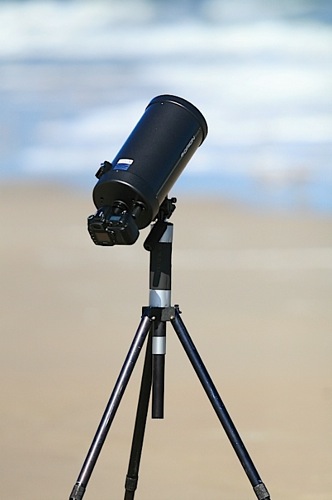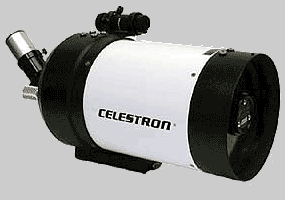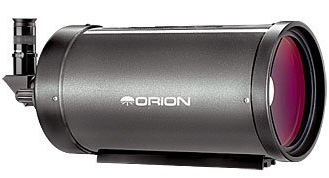Introduction
For birds a considerable distance away, getting a good view is only possible with a spotting scope. Unfortunately, the bewildering array of available spotting scopes in today's market renders the task of choosing one quite difficult. I will offer my own experiences, which have included not only the use of tranditional birding scopes but also the use of astronomical telescopes for watching birds.
Leicas, Swarovskis, and other Pea Shooters
My first birding scope was actually an astronomical telescope. I was using it to observe a family of bald eagles nesting on a tiny island in the Potomac River just outside of Washington, DC. Using an astronomical telescope for bird-watching is somewhat rare, though, and it's probably best to begin with a description of the more traditional birding scopes. My friends and I (who all own huge astronomical telescopes) refer somewhat snobbishly to these more traditional birding scopes (such as the Kowas and Bushnells) as pea-shooters, since they tend to be long and narrow --- that is, they tend to have narrow objective lenses and consequently somewhat restricted light-gathering capabilities. Use of astronomical telescopes for birding is described in the next section.
I myself do own a pea-shooter: the Leica Televid 77 APO. The "APO" designation stands for apochromatic, which means that the unit utilizes high-quality glass to reduce color aberrations. In super-cheap spotting scopes you will sometimes notice strange (often purple) color fringing near high-contrast edges in the image. APO instruments typically utilize special glass elements to eliminate these types of chromatic aberration; sometimes they will employ fluorite glass (as in the case of the Televid APO) or glass designated LD (for Low-Dispersion) or UD (for Ultra-Low-Dispersion). These instruments are generally not cheap.
I think I paid about $1500 for my Televid 77 APO in 1997 or thereabouts. I have been extremely satisfied with it. Not only are the optics superb, but the unit itself is quite rugged. While watching Kestrels in Pennsylvania one winter, a strong wind blew over my rig, and the Televid hit the solid macadam road, leaving several prominent gouges in the external body. But the instrument's optics have remained superb, and the operation remains flawless.
As I remarked in my binocular review, I've always thought that Leica's binoculars had a much nicer-feeling focus knob than Swarovski's. Leica clearly has incorporated its superior focusing technology into its spotting scopes, since I've found that the focus knob on this unit is excellent. The unit actually has two focus knobs (see the photo above). The larger knob is the rough-grained focuser, and the smaller knob is the fine-grained focuser. I always use both. The large knob is good for very rapidly finding the bird I'm trying to look at, whereas the smaller knob is good for fine-tuning the focus one I've got the focus close to where I want it.
My Televid is the angled variety, which means that the eyepiece is at a 45-degree angle to the body. I specifically chose this model for a reason: when observing birds in the rain (such as when I'm trying to nail down the egg-laying date of a pair of bald eagles, who don't necessarily decide not to lay their eggs simply because it's raining outside on a given day), this unit, which is fully waterproof, can be used quite conveniently by adjusting the tropod to the highest setting and rotating the scope within its mounting collar so that the eyepiece points downward. When configured in this way, the surface of the eyepiece will be facing downward and will therefore tend not to get wet; rain droplets on an eyepiece can make viewing virtually impossible. I've actually used this unit in such a setting (ie., a rainy day when a pair of bald eagles looked like they were thinking about laying some eggs) and been able to reliably use the instrument for accurate observations.
It's worthwhile to note here that the available eyepieces for this scope have a maximum magnification of 60x ("sixty power"). It's somewhat comical to compare this to the capabilities of the much larger astronomical scopes described in the next section. I believe that 60x is pretty much the maximum that you're likely to see in any "pea shooter". For higher magnifications you need an astronomical telescope (see below). The Leica actually does accept interchangeable eyepieces, but I only own one -- the 20x-60x zoom. I'm not sure if the Swarovski models accept interchangeable eyepieces, but I'd guess that they probably do. Many other brands don't.
Note also that Leica and Swarovski spotting scopes are all waterproof. The last thing you want is for your $1000+ scope to get ruined simply because you couldn't get back to your car fast enough when the weather turned nasty.
Although I've never owned a Swarovski spotting scope, I've often peered through the 60mm Swarovski scope owned by some friends of mine (who also use theirs to observe eagles in Maryland). One thing that my friends and I agree is that while the 77mm Leica scope has greater light-gathering capacity and is razor sharp in the middle region of the image (and produces a pleasing image overall), the Swarovski 60mm scope is sharp virtually edge-to-edge throughout the viewing area. Just as with the Leica scope, the Swarovski scope is an expensive unit.
Cheaper alternatives do exist. A very popular brand for birding scopes is Kowa. I've rarely looked through these, and have never owned one. Other affordable brands of spotting scopes are avilable through Orion and Eagle Optics. I've never used any of these, but I do know that Orion in particular tends to offer very high-quality products at very low prices.
As was alluded to earlier, all of these "pea shooter" scopes tend to be limited in two significant ways: (1) they tend to have limited light-gathering capacity, due to their narrow objective lenses, and (2) they tend to provide somewhat limited magnification, since the eyepieces available for them through their manufacturers tend to come in a small number of available sizes. For those wanting to transcend these limitations, astronomical telescopes can provide a viable means of doing so.
Astronomical Telescopes for Birding (!)
Although it's unlikely that you'll see birds on the moon or nearby planets through an astronomical telescope, the latter instruments can in fact be used for terrestrial (i.e., Earth-based) viewing of avian subjects.
Indeed, my very first birding scope was in fact a 90mm astronomical telescope known as the Celestron C90. An updated version of the C90 is pictured below:
This pictured version of the C90 has been updated by Celestron to appeal more to the birding market; my own C90 is somewhat older. The newer version is now waterproof, and includes a convenient flip-down lens cap for the objective lens that can be easily closed to protect the lens from offending branches during treks through the woods. The C90 is small and lightweight, and therefore quite easy to carry around.
In the image above you'll notice the eyepiece projecting upward from the right end of the unit. The eyepieces of astronomical telescopes are generally interchangeable, so that eyepieces produced by one manufacturer can be used in conjunction with a telescope made by another manufacturer. This is generally not true with pea shooters such as the Leica, Swarovski, and Kowa scopes described earlier. The advantage is that a much greater range of options are available in terms of the magnification, eye relief, field of view, and optical quality of the eyepieces which can be coupled with any given scope (not to mention the effect of competition on the price).
One also has the option of using special magnifying elements called barlows, which are typically available in 2x and 3x configurations. A 2x barlow is an adapter which, when used in conjunction with a particular eyepiece, doubles the effective magnification of the resulting system, without affecting the eye relief of the inserted eyepiece; this device is equivalent to what photographers call a teleconverter. Barlows can even be stacked, as when extreme magnification is needed to observe distant subjects (accepting that image quality will be much less).
Note that the C90 has a 90mm objective lens diameter, which is more than the common 60mm spotting scopes ("pea shooters") used by most birders. Since the total light admission by a circular lens is proportional to the square of the diameter of the lens, scopes with larger objective lenses enjoy an enormous increase in light-collection capability. This means that (1) images tend to be much brighter through larger scopes, and (2) larger scopes permit the use of greater magnification, since magnification generally reduces image brightness.
My Celestron C90 saw relatively little use, since I upgraded it within about a month to the much larger C5, pictured below:
Astronomical telescopes are not perfect, however. As I noted previously, my Leica Televid has taken quite a beating and continues to operate flawlessly. This is generally the case with refractors, of which most pea-shooter birding scopes are. The term refractor simply refers to a particular class of telescope designs. The Celestron C5 belongs to a different family, known as the Schmidt-Cassegrain design (a form of Catadioptric telescope). Schmidt-Cassegrains tend (unfortunately) to be far more fragile than refractors, due to the delicate nature of their construction. In the case of the Celestron C5, I have found that keeping a C5 in pristine optical condition requires frequent re-collimation (which you can do yourself if you have the patience, or you can pay someone else to do, if you don't). Also, while I have never dropped my C5 onto a hard surface, I strongly suspect, based on its lightweight design, that it would not likely survive a hard impact. Last I checked the C5 ran about $500 new.
Another type of catadioptric telescope is the Maksutov-Cassegrain; the Celestron C90 (mentioned earlier) is one of these. These telescopes tend to be much more durable than the Schmidt-Cassegrains, though they also tend to be heavier and more expensive (when compared at equal diameters).
A larger Maksutov ("Mak" for short) scope which I've used is the 150mm Orion Maksutov telescope, pictured below. This model was previously marketed under the name Argonaut and was of Russian manufacture (and of excessively high quality) though now it is manufactured in China; mine is the Chinese model, though I've looked through both, and believe mine is as good as the Russian version. This model is available for about $600 from Orion --- the same price as the significantly smaller C5.
I have used this scope to observe bald eagles in North Carolina at a nest quite some distance from my observation site (about 4 football-field-lengths away). I have found the optics to be outstanding. Though the unit is quite huge, it is also fairly lightweight (being mostly air), and at $600 is truly a steal. As an added bonus, a digital SLR camera can be mounted to this model very cheaply (using a $15 plastic adapter), allowing the scope to be used as an enormous-focal-length camera lens (click here to see some sample photos taken this way). In the photo below you can see this lens attached to a Nikon D50 digital SLR camera; I was using it that day on the Outer Banks of North Carolina to photograph Willets and Marbled Godwits:.

Which is Best for You?
If you're asking yourself whether it would be best to get a traditional pea-shooter (i.e., Swarovski/Leica/Kowa spotting scope in the 60mm or 77mm/80mm configuration) or instead an astronomical telescope, there are a number of key points to keep in mind.
First, astronomical telescopes are in general not designed for easy transport in the field. They are big (though typically not terrribly heavy) and can be somewhat fragile (especially for Schmidt-Cassegrain types). Some models come with a carrying case, but others do not. The fragile nature of some of them means that frequent re-collimation may be necessary, especially if you plan to leave the instrument in the trunk of your car (which I tend to do, since I go out birding just about every day). None of my scopes have ever required professional repair, but for my C5 I do keep an allen wrench in the case so that I can re-collimate it as necessary in the field.
Astronomical telescopes are typically not waterproof. I'm not sure if Kowa's scopes are waterproof, but the Leicas and Swarovskis certainly are. This can be a real issue if you hike to remote places with your scope, especially in summer when thunderstorms can pop up unexpectedly and soak you and your optics through before you can get back to your car. Taking a large trash bag along can help in these situations to keep the rain from reaching your scope.
Carrying these scopes in the field can be quite difficult because of their size. I tend to mount my scope onto its tripod and then, when moving from one location in the field to another, to just sling the whole assembly over my shoulder. This works quite well with traditional spotting scopes, but with astronomical telescopes it can be a bit tricky. One problem is that the eyepiece assembly tends to shift around when you're carrying the setup around in the field. The eyepiece/barlow assembly can rotate within its mount, causing scoring on the individual elements due to the screws which are intended to fix each element into position. I often worry that if the eyepiece assembly catches on a low-hanging branch it may do more serious damage, though I've yet to have this happen to me. But then again, I don't walk around much with my big Mak telescope; I mostly keep it packed in its padded case until I reach my destination, and then repack it in its case for the trip back to the car.
The primary advantage of astronomical telescopes as birding scopes is their extreme magnification. If you're trying to document the behavior and timeline of nesting events at a raptor nest sitting some distance away from your observation site, then astronomical scopes are highly recommended; I have used them for this purpose for over a decade, and found them to be extremely valuable for this purpose. It should be noted that while many pea-shooter scopes impart a pleasing, slightly yellow cast to the image to increase warmth and saturation, astronomical scopes tend to produce images with a much more neutral color. I've never considered this a serious point for or against either type of scope, but it's worth mentioning.
If waht you want is an instrument which is highly portable and rugged, and for which 60x magnification will generally be sufficent, then a more traditional spotting scope such as those manufactured by Kowa, Leica, and Swarovski may very well be what you need. More affordable packages in this category may be found through discount sites such as Orion and Eagle Optics.
Keep in mind that you will also need a tripod to hold your scope. For larger instruments I recommend a very sturdy model such as those marketed by Davis and Sanford (now owned by Tiffin). Various other brands are available. Look for units having thick padding around the legs, which can significantly ease the task of carrying these over your shoulder during a long day in the field. I made my own leg padding out of pipe insulation from the local hardware store. It's not pretty, but it's far more comfortable than with no padding at all.



